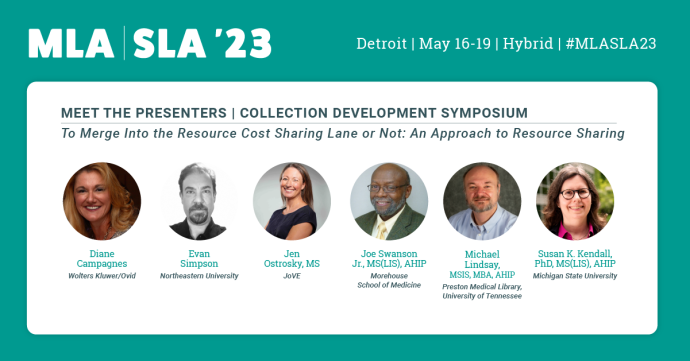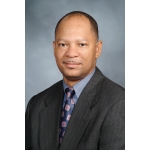Every week until MLA | SLA '23 in Detroit, we profile the experts leading each of the six Collection Development and Resource Sharing Symposium sessions by sharing their answers to questions about themselves and their session.
We continue the series with the presenters and moderators of To Merge into the Resource Cost Sharing Lane or Not: Evaluating and Developing an Approach to Resource Sharing: Diane Campagnes (DC), Evan Simpson (ES), Jen Ostrosky (JO), Joe Swanson, Jr. (JS), Michael Lindsay (ML), and Susan Kendall (SK).
Join them for their session on Wednesday, May 17, 2023 1:30 p.m. - 3:00 p.m, local time in Detroit. To learn about all the Symposium sessions and their presenters, please see the Symposium Session Schedule.
What are you most looking forward to seeing/eating/experiencing in Detroit?
DC: I am truly looking forward to seeing my customers and industry colleagues. Many of my customers are now able to travel and plan to attend MLA in person. It will be so nice to connect face to face and catch up on life! There are lots of great restaurants to try, and Wolters Kluwer is hosting a client appreciation evening event.
ES: I am always inspired when I listen to the conversations of my medical librarian colleagues. There are so many different structures to understand and different needs to grapple with in serving/supporting/collaborating with physicians and medical students. I look forward to learning at MLA.
JO: Aside from our fabulous Resource Cost Sharing session, I'm most looking forward to catching up with librarians I haven't seen in a couple years and meeting others in person I've only "met" over Zoom or email. There's an energy at conferences that I've missed, and I am looking forward to making those in-person connections!
JS: I am looking forward to visiting the Charles H. Wright Museum of African American History. It will also be great to see familiar faces and explore the vendors. There is nothing like seeing demonstrations and getting a timely massage.
ML: My previous MLA experiences have included presenting posters, papers, and even co-hosting a reception. But this is the first time I have been involved with moderating a session of a symposium! I’m really excited to see how it turns out!
SK: I’m looking forward to participating in an in-person program for the first time in three years and catching up with old friends.
What’s a fun or surprising fact about resource cost sharing?
DC: Any discount, even a small one, adds up to an end result that is worthwhile for all participants – never walk away from any amount of savings.
ES: I don't know if this is fun or surprising: in most higher ed institutions, funding is all about networking, relationships, and positioning the library as a partner.
JO: On the surface, resource cost sharing may seem like a "perfect" solution, but it's important to understand all sides of an opportunity before saying "yes." It's kind of like defensive driving: by anticipating adverse conditions, you can more safely navigate your library's path forward.
JS: A surprising fact about resource cost sharing is that libraries from small to very large are concerned about diminishing budgets and practice penny-pinching.
ML: I think people outside of libraries and the publishing industry get the wrong idea about libraries and librarians. Our work is always about people and building relationships. To be successful in resource cost sharing, you have to build relationships with your teaching faculty, administrators, students, and vendors. Resource cost sharing uses many of the skills that are used in negotiations. As in a negotiation, reaching out to explore cost sharing relationships can be uncomfortable at first but are rewarding growth opportunities for your organization and for you personally.
SK: Sometimes cost sharing can be a great way to build institutional relationships and demonstrate value to your organization. Other times, it can be more complicated than it’s worth. The money isn’t always the most important part.
For publishers: What’s an interesting fact about publishing that librarians would be surprised by?
DC: The actual cost of publishing a journal today includes many moving pieces--more researchers are needed; more submissions are received; there is an expectation to decrease the turn-around time; there are higher peer review costs; and increased investment in improving systems, workflow, and staff. Publishers have a balancing act of managing the increasing costs of delivery and maintaining the high quality of journal content.
JO: As part of the JoVE Journal publishing process, we storyboard an experiment's video shoot--similar to what you'd see in a cooking show. After a shoot, a post-production crew brings a video article to a form ready for publication.
For librarians: What’s an interesting fact about libraries that publishers would be surprised by?
ES: We have prepared our communities for radical shifts and disruptions in information access and publishing.
JS: An interesting fact about libraries that publishers would be surprised by is the participation of libraries in their communities. Academic libraries have conducted outreach seminars on how to utilize the resources of the National Library of Medicine and workshops on Disaster Preparedness.
ML: I’m not sure how much of a surprise this is, but before working in libraries I never realized the role that metrics play in our work. We measure everything--how many people come in the door, utilization of study rooms, how many downloads we get from a journal or database, and, of course, hits on our website, literature searches, and so much more. Justifying the investment our institutions entrust to us requires a great deal of data collection and analysis!
SK: Sometimes we’re serving thousands of users from a distance that we will never communicate directly with.
How did you get started in libraries or publishing?
DC: I had taken auto mechanics in high school and worked at a gas station servicing cars. When work was slow, I would tutor the three gentlemen that worked with me in math and English. One day the father of one person I tutored came by to thank me for helping his son pass and graduate. We got to chatting, and he asked me if I knew how to type. I responded that I could type 120 words a minute. He offered me a job at Springer Verlag typing invoices and general office work at $3.00 more an hour! This was my introduction to publishing. From there I went to work for SIRS, Inc in the Customer Service and Accounting departments. One day, a sales representative got sick and could not attend ALA. So, at 20 years old, I attended my first ALA in San Francisco. I met a woman from the US Air Force Libraries and ended up making the largest sale in the history of the company. From there, I became a publisher representative, National Sales Manager, and, finally, VP of Sales. I have been with Wolters Kluwer / Ovid for 17 years. I have spent my entire 35-year career working with librarians and libraries. I have not regretted one moment!
ES: I started off as a planned giving fundraiser for a major nonprofit. One day, I realized we weren’t using or sharing information very well. That insight led me to an actual library, and here I am!
JO: After my master's, I worked for a large pharma company for a decade and held positions in sales and customer service. After my first child, I took a hiatus from the "paid" working life. When my second child was a few months old, I serendipitously found out about the growing sales team at JoVE. I didn't really know anything about publishing, but I knew how to build and foster relationships and I understood research and hospitals. I started with JoVE 11 years ago with a focus on hospitals and government libraries and, in 2017, expanded to academia. It has been a very rewarding journey in which every day is a little different. That 3-month-old baby is now every bit a tween!
JS: My road to librarianship: In high school, I worked in the school library and then the public library. In college, I worked in the college library. After graduation, I entered library school.
ML: In my first career, I was an insurance agent. It was exciting and challenging for a while, but after several years I was ready for a change. I met someone doing data analysis for our call center, and her work really sounded intriguing. She was working on an information sciences degree. After going through the program, I noticed several jobs opening up in electronic services librarianship. This seemed to me to be an ideal way of combining my interests in technology and my background in customer service and contracts work. After twenty years of work in the field, I can say it has been so much more than I expected.
SK: I was working as a scientist and looking for a career change. My sister, a public librarian, suggested I think about academic librarianship. I found some medical librarians, met them for informational interviews, and discovered that it just might be a good fit.
What’s the most rewarding part of working with librarians or publishers?
DC: Librarians are a wealth of knowledge. They are passionate about what they do and about making a difference every day. The best part of my job is my interaction with my customers, many of whom become dear friends. The library world is a very special community and holds a special place in my heart.
ES: When we all come together and solve problems. My library recently worked with publishers to improve interfaces and address accessibility and include marginalized voices through more inclusive subjects/terms and pilot e-book lending.
JO: I truly value the relationships I've created over the years, and I view my work with librarians as a partnership. The other part of my job that is rewarding is knowing that the content I'm helping to bring to researchers, students, and faculty has a positive impact on their work.
JS: The most rewarding part of working with librarians is that librarians are friendly, believe in sharing, and are not the dull individuals depicted in the media.
ML: There is an openness and commitment to shared goals among librarians that I haven’t seen in any other job that I have had. Every time I have needed help in understanding something, I have always found my librarian colleagues to be generous in their help and support!
SK: Learning about the kinds of products that are coming out and the novel publishing models that provide new ways for our users to access knowledge.
What’s the main thing you hope participants will take away from your contribution to the session?
DC: Ideas on how publishers and libraries can maximize efforts to provide quality content and databases to patrons.
ES: We have to be both data-driven and relationship-driven. We have to be ready with different views of usage and impact and be willing to put the time into relationship-building.
JO: To have an increased awareness of how resource cost sharing opportunities can play out and to take the panelists' perspectives and apply them to how they approach opportunities. I hope that this is a very practical session.
JS: The exposure to this symposium will encourage librarians to participate in cost-reduction groups or start a group.
ML: I would say the importance of being open to creating partnerships in and out of their organization to bring resources to those they serve.
SK: To think about all the kinds of resource cost sharing models that are possible and be able to consider the pros and cons of different proposals.




